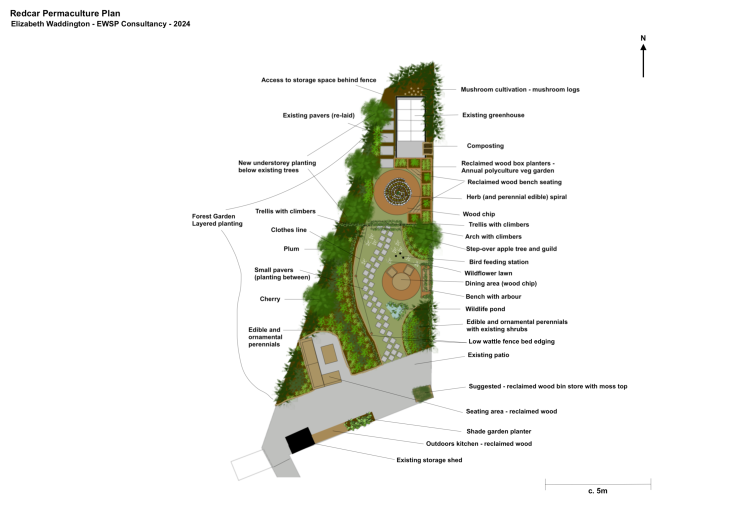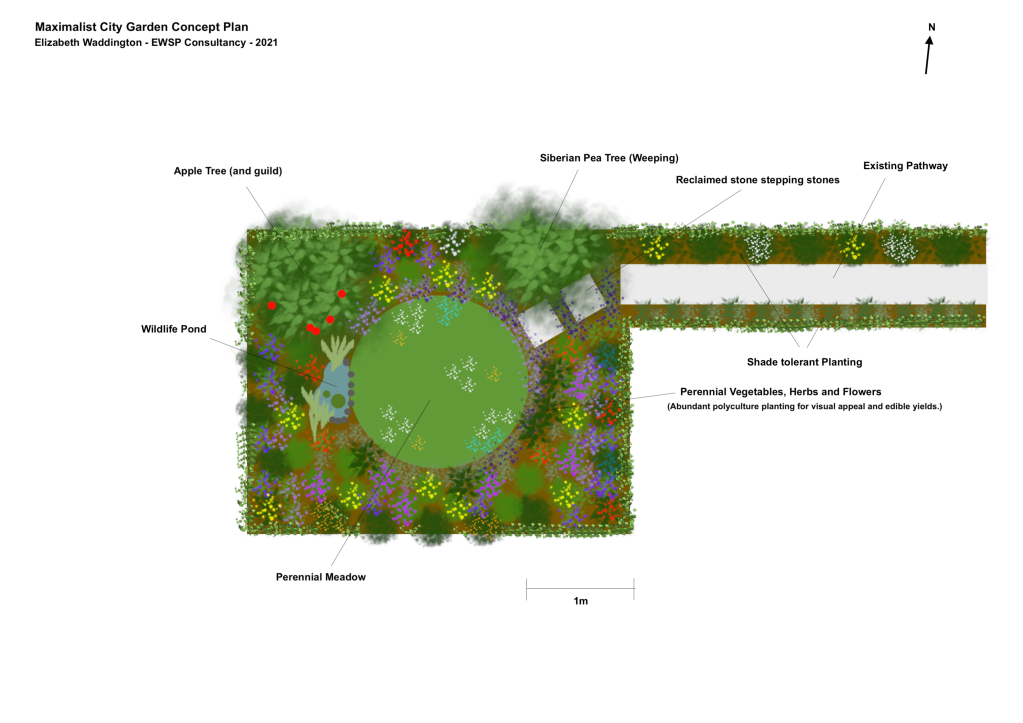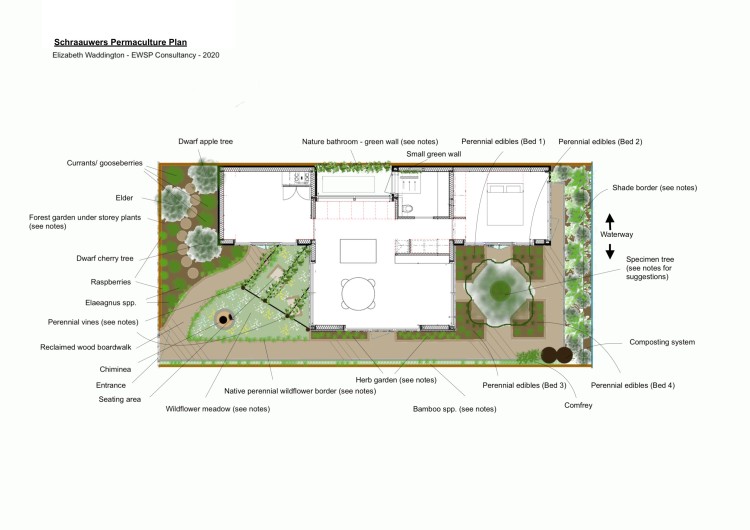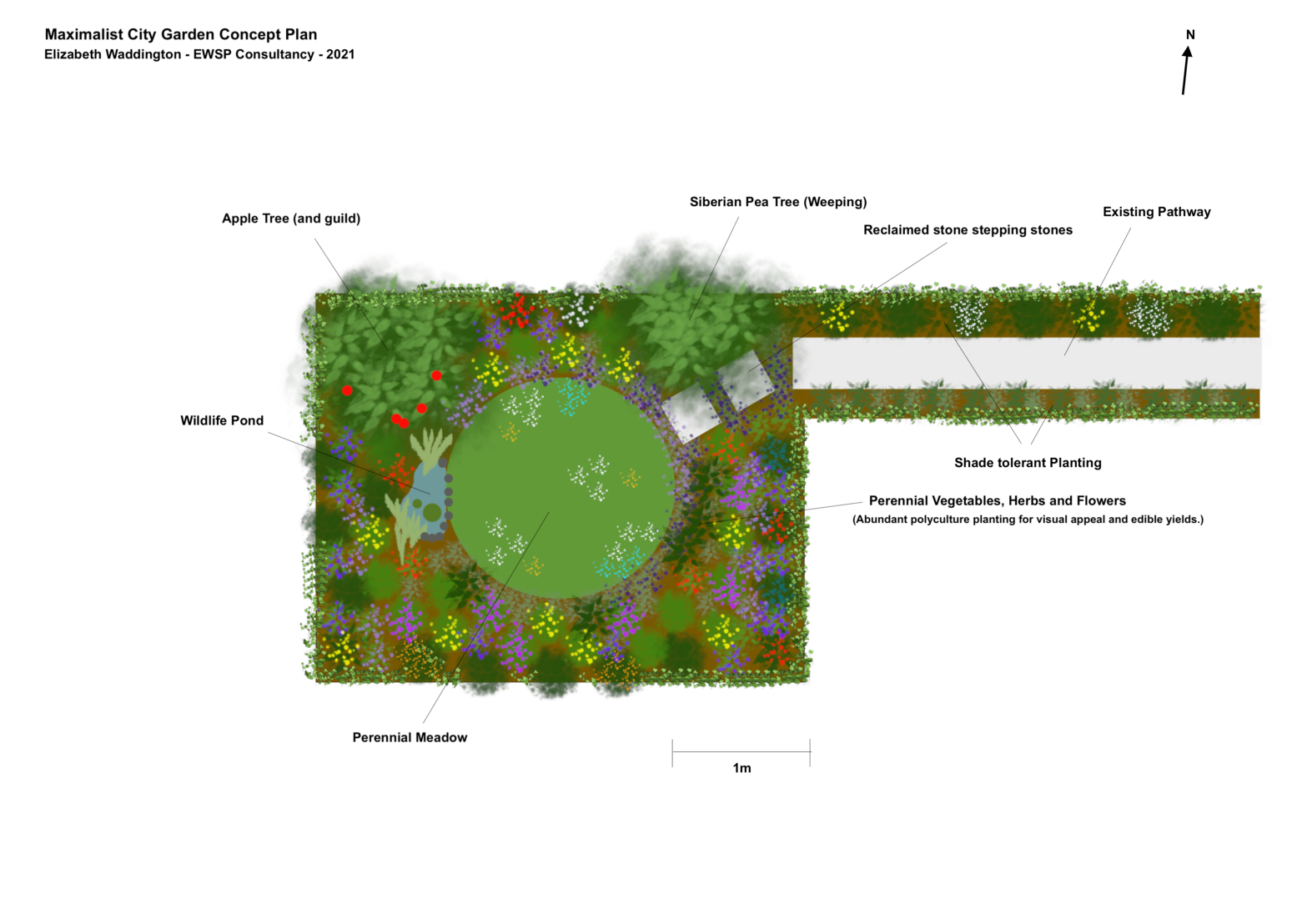You do not need to have a large garden to adhere to permaculture ethics and principles. Even in the smallest spaces you can obtain a yield and grow at least a little of your own food, while still having some space for recreation. Small gardens can often deliver far more than you might think.
Understanding and Appreciating Small Gardens

In any garden, large or small, it is important to get to know the space before you make any design decisions or do anything with it.
One advantage that you will have with a small garden is that it will take less time and frequently be easier to get to know the space intimately before you begin.
Small gardens, of course, differ not only in their actual size (how small is small?) but also in the environmental conditions that they can provide.
Some may be little sun-traps, while others are very shaded, for example. You will of course need to bear the environmental conditions in mind when making any design decisions.
The major challenge with all small gardens is their size. But their size can also be an advantage, allowing you to spend more time planning and tending them. Bear in mind that over a larger garden, your attention would naturally be spread more thin.
Small Garden Design Guidelines
These practical design tips can help you consider key elements of your design and ensure that you make the most of the space available in your small garden:
1. Add Multi-Functional Elements

Every element that you add within a garden should have multiple functions, and, ideally, for every function you should have multiple elements to provide it.
Multi-functionality is especially important in small gardens, where space is at a premium. And we should try to take special care to build in redundancy in our systems to make them more resilient.
A single fruit tree is a good example of a multi-functional element that you might add to a tiny garden. Even a very small fruit tree can provide shade, an edible yield, benefits for wildlife, and perhaps even enrich kids play allowing them to duck under, run around, or maybe even climb it once it matures.
Multi-functionality can also come in when we are creating man-made structures. For example, the edge of a raised bed might also be bench seating, and if we hinge the bench seat and build in below we can create a storage space too, or even a space for a kids’ sandpit, or other play feature.
2. Layer in Space and Time

Layering is important in small-space gardens. By creating tiered planting schemes with trees, shrubs, herbaceous plants and climbers, we can boost biodiversity and ensure that we maximise photosynthesis and get yields as high as possible.
We should not only think about layering in space, but also in time. We should not only think about the physical area available for growing crops and other plants, but also about the time available throughout the year.
Successional sowing, as well careful companion planting and polyculture creation can help us make the most of the time as well as the space available. So it is important to have a sowing and planting plan for a small garden that allows you to maximise yields over time as well as space.
For example, we can sow quick growing lettuces and/or radishes between slower growing cabbage-family crops and harvest these before the cabbage-family crops need the space.
3. Think Vertically as Well as Horizontally
Of course, when we layer plants in space, we are working on the vertical plane. But we can go much further with vertical gardening and reach for the skies. There are often few limits in a small garden to how high we can potentially go, even when horizontally we are very limited.
Practical vertical gardening strategies might include:
- Shelving – either free-standing or on a wall or fence, with pots or other containers for plants.
- Vertical gardens with planting pockets made from old wood pallets, reclaimed fabric, etc… (For example, you can use the fabric from an old waterproof jacket or tent no longer fit for use to sow a small vertical garden with pockets you can fill with a potting mix to plant into.)
- Trellis structures for climbing/vining plants made from a range of natural or reclaimed materials. (Trellis might be made from long natural branches or bamboo canes, natural twine, reclaimed wood like pallets, old fencing slats and posts, old ladders, etc… or metal like old metal bed frames, rebar left over from a construction project, old cattle panels etc… to give just a few examples.)
- Hanging Containers – hanging baskets and also other reclaimed containers like milk jugs or 5 gallon buckets that might be used to grow plants suspended above the ground. You might hang these from walls or fences, or even string them on canes or wire across the garden.
- Planting towers – any containers or constructed towers with space for planting in the sides as well as the top – great for growing strawberries and salad leaves, for example. one way to make a planting tower is to cut and stack a series of plastic bottles, another is to cut holes in the sides of an old 50 gallon drum or other large container.
- Tiered planters – placing smaller planters on top of larger ones can help you create larger growing area that can accommodate more plants.
4. Consider Access Carefully
As important as planting is to any small garden design, it is also important to think about other practical elements. Make sure you consider how you will access and move around the space. Being able to move around the space, however small, can be important not only for ease of use, but also to make the space feel bigger than it actually is.
5. Use Every Inch of Space
At the same time as ensuring that the space does not feel overcrowded though, and that access is maintained, you also need to make sure that you are making full use of every inch of space.
Consider edges and tiny spaces that might be overlooked – along the base of a fence, for example, or on your back step. Think about how every tiny space might be used.
The neglected space, for example, along a back wall beside a down pipe from the guttering might be used to create a tiny raised garden pond, and overspill raised bed wetland garden.
Creating Small Gardens

Beyond the basics of design, it is important to think about the practicalities of actually creating your small garden. Below are some practical tips and guidelines to consider:
New Growing Areas for Small Gardens
- Remember that there are a range of different containers you might use, including vertical gardening solutions.
- Raised beds can often work well, even when working with paved areas. These dry out less quickly than containers. Don’t buy expensive things to make and fill your beds, try to use reclaimed materials and natural ones where possible.
Paving and Pathways for Small Gardens
- Keep paving and hard pathways in proportion – make sure you do not pave too much of a small garden or it can feel out of balance. Use reclaimed (e.g. reclaimed stones, bricks, ceramics, even glass bottles) or natural materials (e.g. found rocks and stones) where possible.
- Make clear pathways (from natural or reclaimed materials like wood chip, stone pavers or compacted stones/gravel) to retain accessibility, but consider using plants for living pathways, or placing plants between pavers, to make the most of all your space.
Seating Areas for Small Gardens
- Make sure seating areas serve multiple functions, with integrated planting areas, perhaps, and/or opening to reveal storage or further features.
- Add arbour structures or pergolas that shade the seat below while also providing a support for climbing/vining plants, support for an end of a washing line, perhaps, and/or provide a place from which to hang a hanging container.
Wildlife Attraction in Small Gardens
- Aim to create mini versions of broader habitats like hedgerows, meadows etc…
- Create a small pond with an old washing up bowl or other old container sunk into the soil, with rocks and sticks to make sure creatures can get out, and a few native aquatic/ marginal plants.
- Try to leave one small corner wild for wildlife, with a brush pile or similar, and leave it undisturbed.
These are just some practical tips to help you make the most of your small garden.
